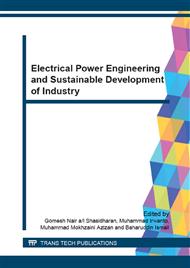[1]
G. L. Arindam Gosh, Power Quality Enhancement Using Custom Power Devices. AH Dordrecht: Kluwer Academic Publisher Group, 2002, p.4–6.
Google Scholar
[2]
H. Akagi, E. H. Watanabe, and M. Aredes, Instantaneous Power Theory and Applications to Power Conditioning. Hoboken, New Jersey: John Wiley & Sons, Inc., (2007).
DOI: 10.1002/0470118938
Google Scholar
[3]
N. Mariun, A. Alam, S. Mahmod, and H. Hizam, Review of Control Strategies for Power Quality Conditioners, in National Power & Energy Conference (PECon) Proceedings, 2004, p.109–115.
DOI: 10.1109/pecon.2004.1461626
Google Scholar
[4]
D. Masand, S. Jain, and G. Agnihotri, Control Algorithms for Distribution Compensator, in IEEE ISIE, 2006, p.1830–1834.
DOI: 10.1109/isie.2006.295850
Google Scholar
[5]
D. Masand, S. Jain, and G. Agnihotri, Control Strategies for Distribution Static Compensator for Power Quality Improvement, IETE J. Res., vol. 54, no. 6, (2008).
DOI: 10.4103/0377-2063.48632
Google Scholar
[6]
V. K. Kannan and N. Rengarajan, Investigating the performance of photovoltaic based DSTATCOM using I cos U algorithm, Int. J. Electr. Power Energy Syst., vol. 54, p.376–386, (2014).
DOI: 10.1016/j.ijepes.2013.07.027
Google Scholar
[7]
Transmission and Distribution Committee of the IEEE Power and Energy Society, IEEE Recommended Practice and Requirements for Harmonic Control in Electric Power Systems, (2014).
Google Scholar
[8]
P. Giroux and G. Sybille, DSTATCOM Average and Detailed Model., Mathworks.
Google Scholar
[9]
P. Giroux, G. Sybille, and H. Le-Huy, Modeling and Simulation of a Distribution STATCOM using Simulink's Power System Block, in IECON01: The 27th Annual Conference of the IEEE Industrial Electronics Society Modeling, 2001, vol. 00, no. C, p.990.
DOI: 10.1109/iecon.2001.975905
Google Scholar
[10]
R. S. Herrera, P. Salmerón, and H. Kim, Instantaneous Reactive Power Theory Applied to Active Power Filter Compensation: Different Approaches, Assessment, and Experimental Results, IEEE Trans. Ind. Electron., vol. 55, no. 1, p.184–196, (2008).
DOI: 10.1109/tie.2007.905959
Google Scholar
[11]
S. Bhattacharya and D. Divan, Synchronous Frame Based Controller Implementation for A Hybrid Series Active Filter, " in Industry Applications Conference, 1995. Thirtieth IAS Annual Meeting, IAS , 95., Conference Record of the 1995 IEEE (Volume: 3 ), 1995, p.2531.
DOI: 10.1109/ias.1995.530625
Google Scholar
[12]
B. Singh and V. Verma, Selective Compensation of Power-Quality Problems Through Active Power Filter by Current Decomposition, IEEE Trans. Power Deliv., vol. 23, no. 2, p.792–799, (2008).
DOI: 10.1109/tpwrd.2007.911108
Google Scholar
[13]
P. Kumar, N. Kumar, and A. K. Akella, A simulation based case study for control of DSTATCOM., ISA Trans., vol. 53, no. 3, p.767–75, May (2014).
DOI: 10.1016/j.isatra.2013.11.008
Google Scholar
[14]
B. Singh and J. Solanki, A Comparison of Control Algorithms for DSTATCOM, IEEE Trans. Ind. Electron., vol. 56, no. 7, p.2738–2745, (2009).
DOI: 10.1109/tie.2009.2021596
Google Scholar
[15]
B. Singh, G. Bhuvaneswari, and S. R. Arya, Review on Power Quality Solution Technology, Asian Power Electron. J., vol. 6, no. 2, p.19–27, (2012).
Google Scholar
[16]
K. R. Padiyar, FACTS Controllers in Power Transmission and Distribution. New Delhi: New Age International (P) Limited, Publishers, (2007).
Google Scholar
[17]
B. Singh, P. Jayaprakash, and D. P. Kothari, A Three-Phase Four-Wire DSTATCOM for Power Quality Improvement, J. Power Electron., vol. 8, no. 3, p.259–267, (2008).
DOI: 10.1109/indcon.2008.4768759
Google Scholar


